On the Design of Efficient Hierarchic Architecture for Software Defined Vehicular Networks
Abstract
1. Introduction
1.1. Contributions
- We proposed a novel efficient architecture for SDVN to improve the QoS using a priority-based scheduling algorithm.
- We prioritize traffic flow messages both in safety and non-safety queues.
- In the safety queue, the messages are prioritized based on deadline and size using the NDS with constrained location and deadline.
- In contrast, the non-safety queue is prioritized based on the FCFS algorithm.
- We used a well-known cloud computing framework CloudSim toolkit to simulate the proposed priority-based scheduling algorithm in hierarchic SDVN architecture.
1.2. Paper Organization
2. Related Work
2.1. Overview of VANETs
2.2. Overview of SDN
2.3. Overview of SDVN Architecture
2.4. Scheduling Schemes Used in SDVN and VANET
3. Proposed Scheme
3.1. Proposed Hierarchic Architecture for SDVN
3.1.1. Network Model
3.1.2. SDN Controller
3.1.3. SDN Nodes
3.1.4. SDN Road Side Unit
3.1.5. Trusted Authority (TA)
3.1.6. Database
3.1.7. SDN Cloud
3.1.8. Priority Based Scheduling Algorithm
- Multiple vehicles send requests/messages for different services; these requests are stored in the queue.
- Each request is forwarded one by one to the SDN controller.
- The SDN controller is connected to the cloud where various computations are performed, such as services are categorized into safety and non-safety messages. Then these messages are sent back to the SDN controller.
- Scheduling algorithm assigns the priority to emergency messages based on deadline and size. The message having the least deadline and smallest length will be considered for higher priority among all services.
- The services are forwarded to the output queue to the given priority, as shown in Figure 2.
- The vehicles efficiently receive their services.
- For non-safety messages, the requests are categorized based on FCFS.
| Algorithm 1: For Vehicles/Nodes request to cloud. |
| Input: Request type |
| Output: List of request L1. |
| 1. for |
| // vehicle request |
| 2. |
| // Request Type (vehicle can send multiple requests such as nearest ATM, nearest petrol pump, natural disaster, police helpline, rescue, etc. |
| // are vehicles. |
| 3. L1= Add request of vehicle (i) // vehicle |
| 4. Return L1 |
| 5. End of for |
| Algorithm 2: Data categorization by cloud. |
| Input: List of the request of vehicle L1 |
| Output: L2 and L3 safety and non-safety list of requests. |
| 1. for |
| 2. if (“ambulance”, “hospital emergency”, “police helpline”, “rescue” )) |
| 3. Assign |
| 4. else assign |
| End if |
| 5. Return L2 and L3 |
| End of for |
| Algorithm 3: Prioritization of Safety and Non-Safety List (i.e., ). |
| Input: and |
| Output: and lists i.e., prioritize the list of safety and non-safety messages are sent to vehicles |
| 1. for |
| // Q1 is the random list of L3. |
| 2. for |
| Find min |
| // Build list from minimum to maximum |
| End for |
| 3. Non-Safety for (j=1; j<=length of L3; j++) |
3.1.9. A Walk-trough Example
4. Simulation and Analysis of Priority-Based Scheduling Algorithms
4.1. Simulation Setup
4.2. Experimental Evaluation
4.3. Simulation Result
5. Conclusions
Author Contributions
Funding
Institutional Review Board Statement
Informed Consent Statement
Data Availability Statement
Conflicts of Interest
References
- Shin, M.K.; Nam, K.H.; Kim, H.J. Software-defined networking (SDN): A reference architecture and open APIs. In Proceedings of the IEEE 2012 International Conference on ICT Convergence (ICTC), Jeju Island, Korea, 15–17 October 2012; pp. 360–361. [Google Scholar]
- Kreutz, D.; Ramos, F.M.V.; Verissimo, P.E.; Rothenberg, C.E.; Azodolmolky, S.; Uhlig, S. Software-defined networking: A comprehensive survey. Proc. IEEE 2015, 103, 14–76. [Google Scholar] [CrossRef]
- Singh, S.; Sunil, A. VANET routing protocols: Issues and challenges. In Proceedings of the 2014 Recent Advances in Engineering and Computational Sciences (RAECS), Chandigarh, India, 6–8 March 2014; pp. 1–5. [Google Scholar]
- Pankaj, K.; Chakshu, G.; Inderjeet, S. Performance Evaluation of Network Aggregation Techniques in VANET. IJIREEICE 2017, 5, 36–39. [Google Scholar]
- Mousa, S.H.; Ismail, M.; Nordin, R.; Abdullah, N.F. Effective wide spectrum sharing techniques relying on CR technology toward 5G: A survey. J. Commun. 2020, 15, 122–147. [Google Scholar] [CrossRef]
- Goudarzi, S.; Anisi, M.H.; Ahmadi, H.; Musavian, L. Dynamic Resource Allocation Model for Distribution Operations using SDN. IEEE Internet Things J. 2020, 8, 976–988. [Google Scholar] [CrossRef]
- Kalinin, M.O.; Krundyshev, V.M.; Semianov, P.V. Architectures for building secure vehicular networks based on SDN technology. Autom. Control Comput. Sci. 2017, 51, 907–914. [Google Scholar] [CrossRef]
- Toufga, S.; Abdellatif, S.; Assouane, H.T.; Owezarski, P.; Villemur, T. Towards Dynamic Controller Placement in Software Defined Vehicular Networks. Sensors 2020, 20, 1701. [Google Scholar] [CrossRef] [PubMed]
- Soleymani, S.A.; Goudarzi, S.; Anisi, M.H.; Kama, N.; Adli Ismail, S.; Azmi, A.; Hanan Abdullah, A. A trust model using edge nodes and a cuckoo filter for securing VANET under the NLoS condition. Symmetry 2020, 12, 609. [Google Scholar] [CrossRef]
- Sadio, O.; Ngom, I.; Lishou, C. Design and Prototyping of a Software Defined Vehicular Networking. IEEE Trans. Veh. Technol. 2019, 69, 842–850. [Google Scholar] [CrossRef]
- Al-Mayouf, Y.R.B.; Abdullah, N.F.; Mahdi, O.A.; Khan, S.; Ismail, M.; Guizani, M.; Ahmed, S.H. Real-time intersection-based segment aware routing algorithm for urban vehicular networks. IEEE Trans. Intell. Transp. Syst. 2018, 19, 2125–2141. [Google Scholar] [CrossRef]
- Thota, J.; Abdullah, N.F.; Doufexi, A.; Armour, S. V2V for vehicular safety applications. IEEE Trans. Intell. Transp. Syst. 2019, 21, 2571–2585. [Google Scholar] [CrossRef]
- Alioua, A.; Senouci, S.-M.; Moussaoui, S.; Sedjelmaci, H.; Messous, M.-A. Efficient data processing in software-defined UAV-assisted vehicular networks: A sequential game approach. Wirel. Pers. Commun. 2018, 101, 2255–2286. [Google Scholar] [CrossRef]
- Singh, S.; Negi, S.; Verma, S.K. VANET based p-RSA scheduling algorithm using dynamic cloud storage. Wirel. Pers. Commun. 2018, 98, 3527–3547. [Google Scholar] [CrossRef]
- Zhang, Y.; Zhao, J.; Cao, G. On scheduling vehicle-roadside data access. In Proceedings of the fourth ACM international workshop on Vehicular ad hoc networks, Montreal, QC, Canada, 10 September 2007; pp. 9–18. [Google Scholar]
- Kumar, R.; Pal, R.; Prakash, A.; Tripathi, R. A Collective Scheduling Algorithm for Vehicular Ad Hoc Network. In Recent Trends in Communication, Computing, and Electronics; Khare, A., Tiwary, U., Sethi, I., Singh, N., Eds.; Springer: Singapore, 2019; pp. 165–180. [Google Scholar]
- Zhu, W.; Gao, D.; Zhao, W.; Zhang, H.; Chiang, H.-P. SDN-enabled hybrid emergency message transmission architecture in internet-of-vehicles. Int. J. Enterp. Inf. Syst. 2018, 12, 471–491. [Google Scholar] [CrossRef]
- Singh, S.; Negi, S.; Verma, S.K.; Panwar, N. Comparative study of existing data scheduling approaches and role of cloud in vanet environment. Procedia Comput. Sci. 2018, 125, 925–934. [Google Scholar] [CrossRef]
- Shahverdya, M.; Asgarib, M.; Fathyc, M. A qos-based scheduling algorithm in vanets. J. Theor. Appl. Inf. Technol. 2015, 77, 429–437. [Google Scholar]
- Lim, J.M.-Y.; Chang, Y.C.; Alias, M.Y.; Loo, J. Performance modelling of adaptive VANET with enhanced priority scheme. KSII Trans. Internet Inf. Syst. 2015, 9, 1337–1358. [Google Scholar]
- Javad, S.M.; Mahmood, F. A new approach in packet scheduling in the VANET. arXiv 2010, arXiv:1010.0430. [Google Scholar]
- Dubey, B.B.; Chauhan, N.; Chand, N.; Awasthi, L.K. Priority based efficient data scheduling technique for VANETs. Wirel. Netw. 2016, 22, 1641–1657. [Google Scholar] [CrossRef]
- Wadhonkar, A.; Deepti, T. An Analysis of Priority Length and Deadline Based Task Scheduling Algorithms in Cloud Computing. IJCSN 2016, 5, 360–364. [Google Scholar]
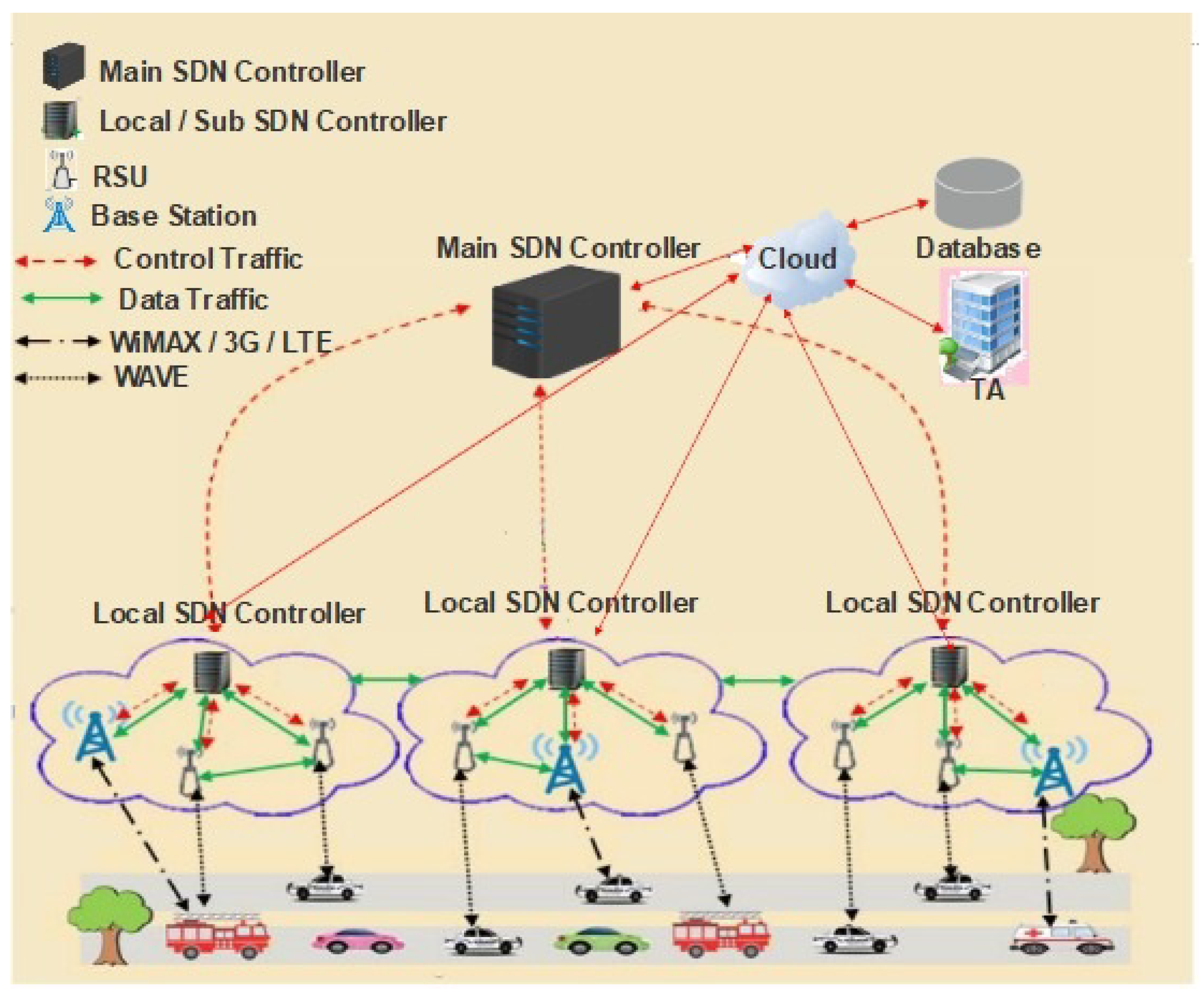
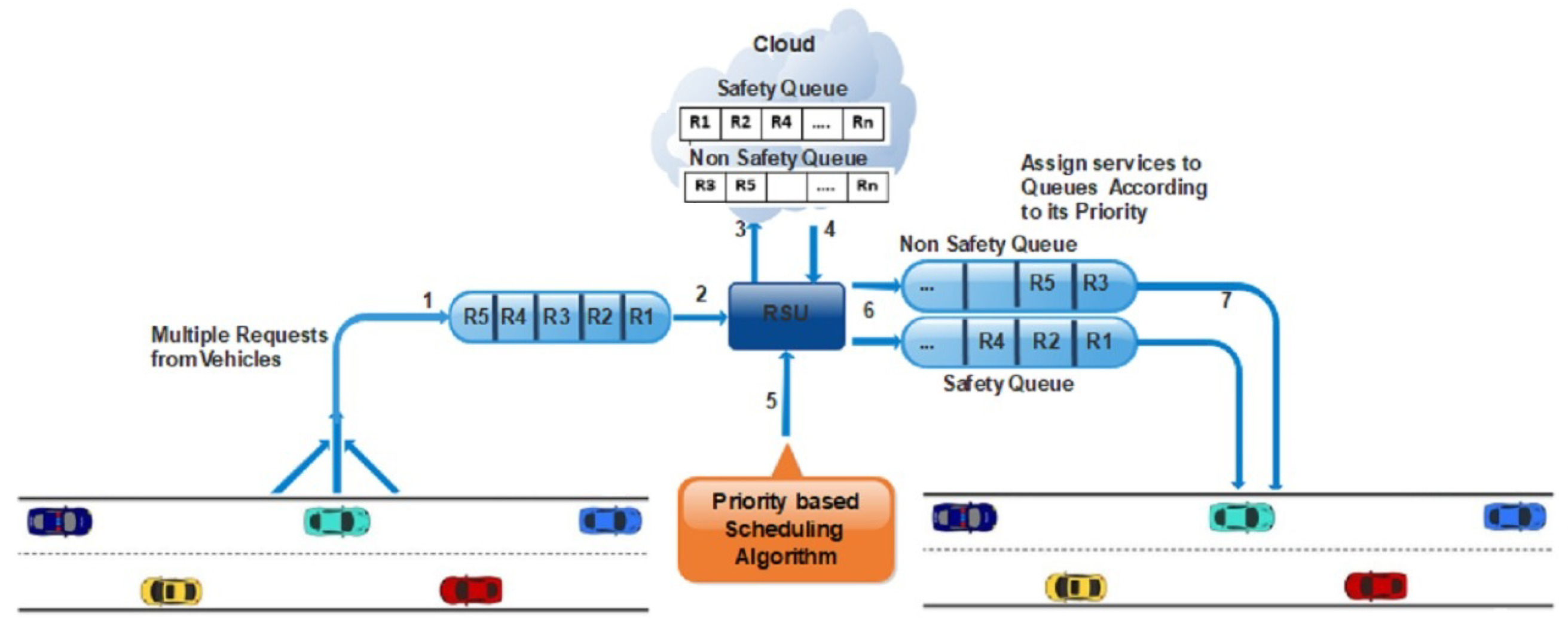
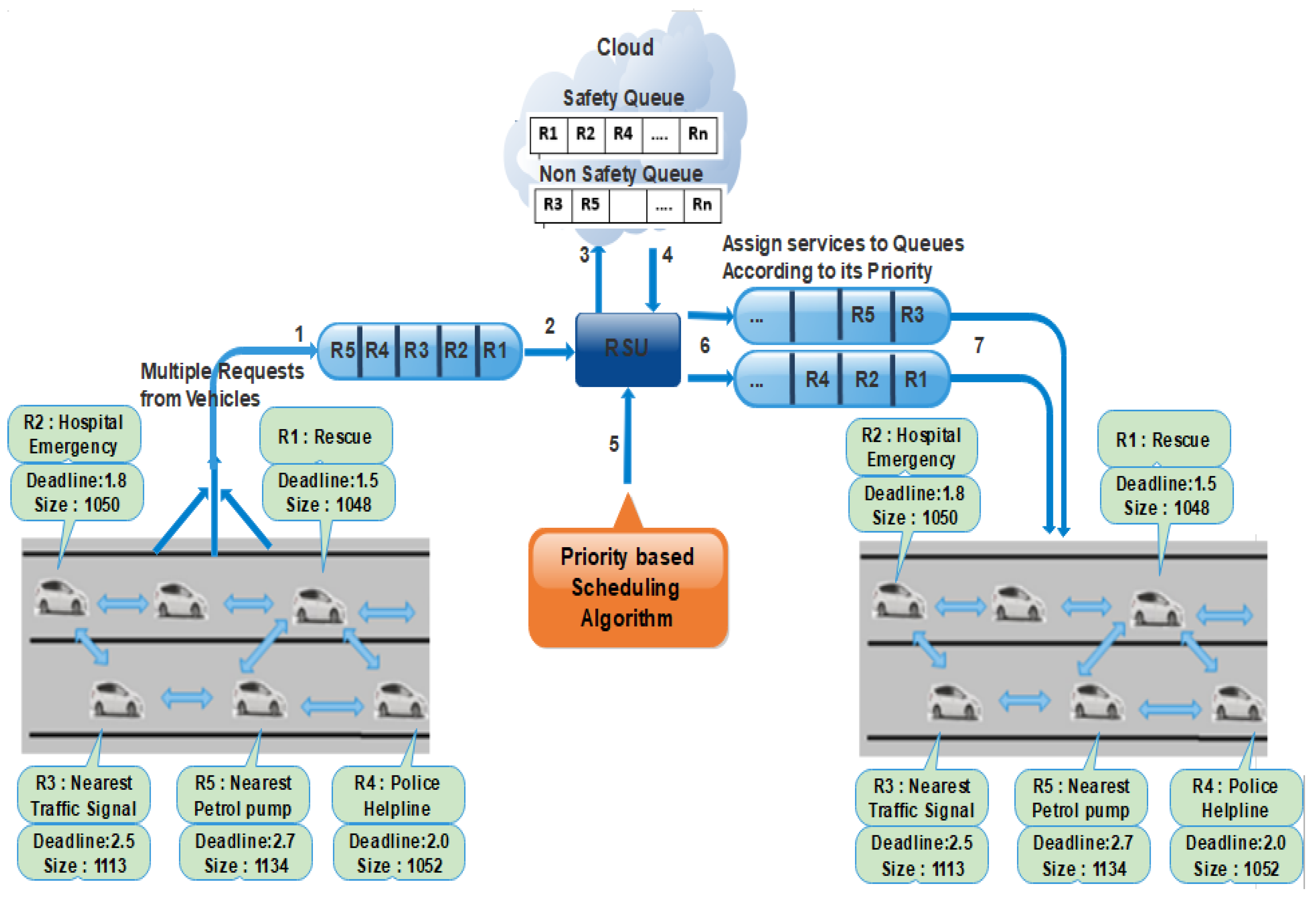
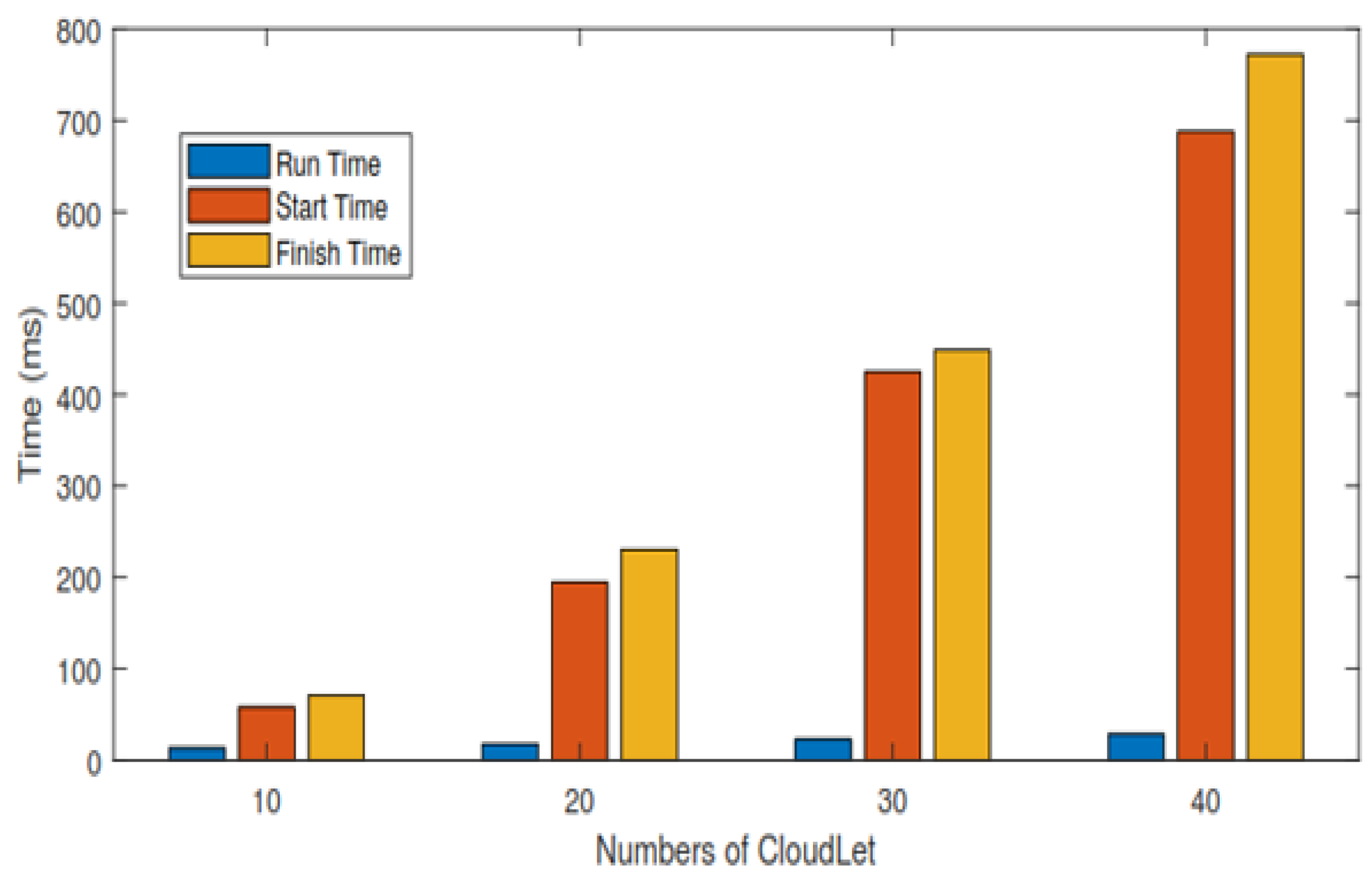
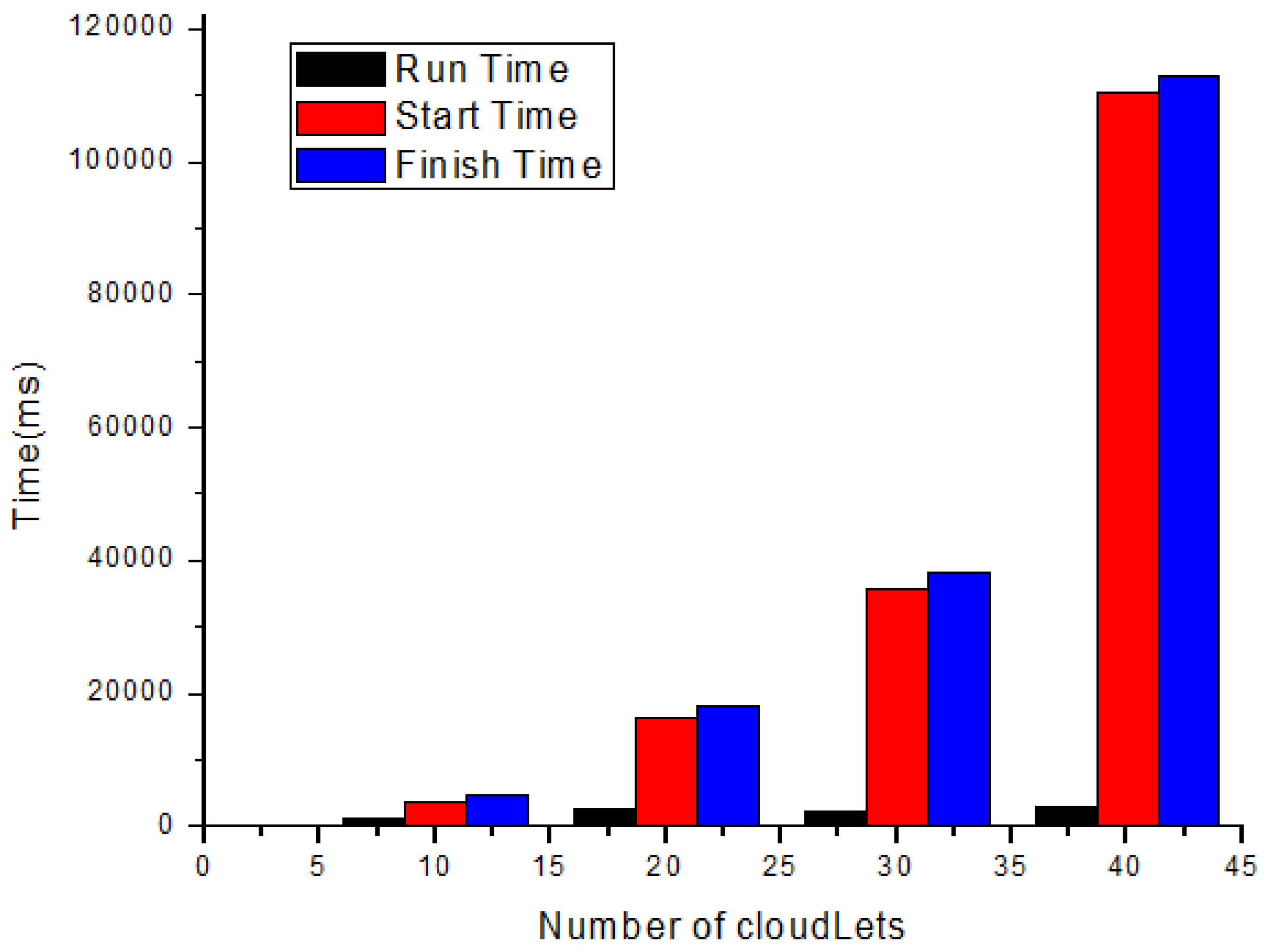


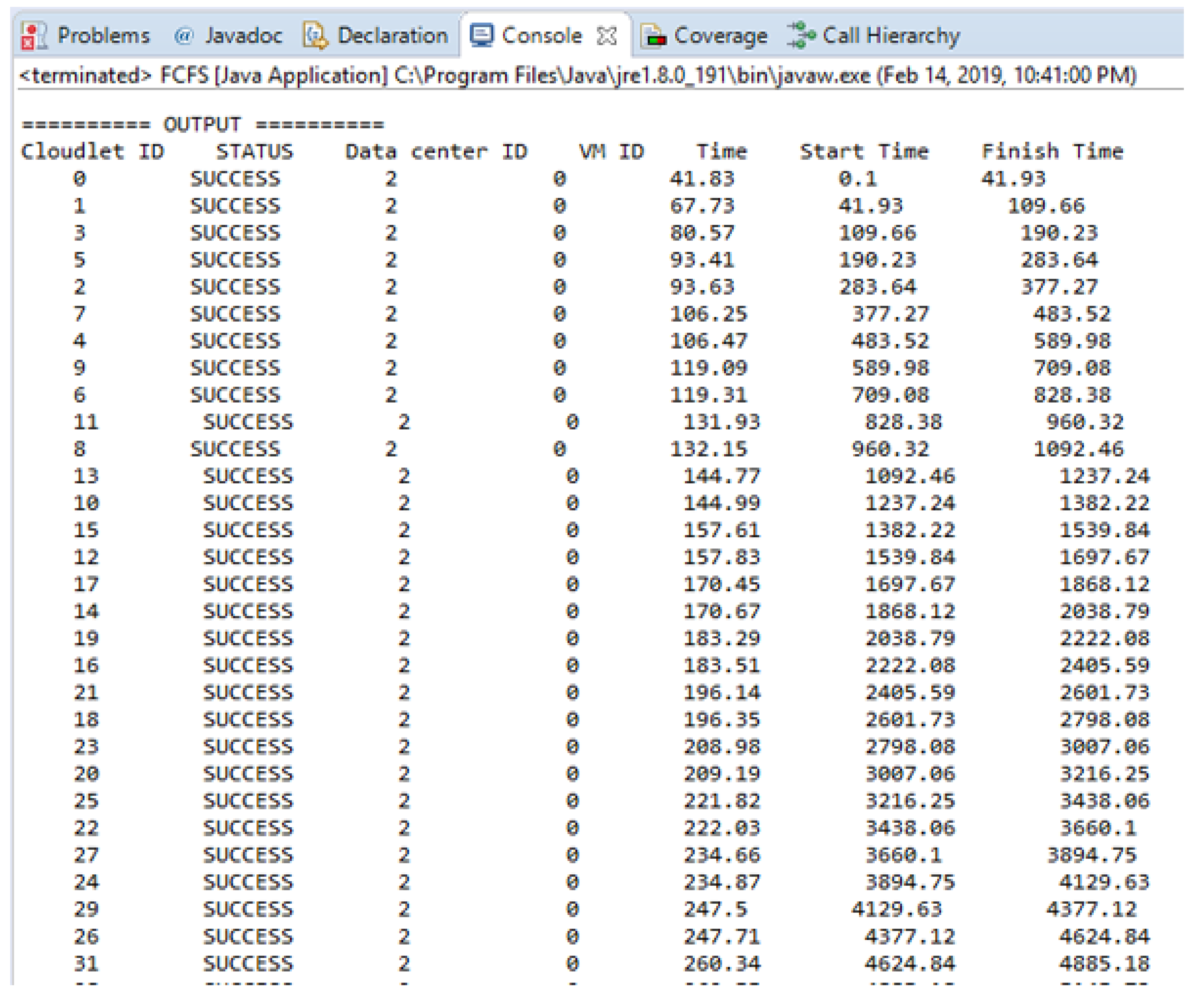
| Notations | Description |
|---|---|
| Application Unit | |
| Quality of Service | |
| Software Defined Networks | |
| Vehicular Adhoc Networks | |
| Priority-based Scheduling Algorithm | |
| New Deadline and Size of data method | |
| First Come First Serve | |
| Software Defined Vehicular Network | |
| Intelligent Transportation System | |
| Mobile Ad hoc Networks | |
| Vehicle-to- Vehicle | |
| Vehicles-to-Roadside | |
| Vehicles-to-Infrastructure | |
| Application Programming Interface | |
| Multi-access Edge Computing | |
| SDN Based Vehicle Ad hoc On-Demand | |
| Optimize Link State Routing | |
| Dynamic Source Routing | |
| Destination Sequence Distance Vector | |
| Distance Based routing | |
| Unmanned Aerial Vehicle | |
| priority-based RSA algorithm | |
| Shortest job based on Data First | |
| Hybrid Emergency Message Transmission | |
| Internet of Vehicle | |
| Road Side Unit | |
| Vehicle Multi-hop Broadcast Trigger | |
| Base Stations | |
| North Bound Interface | |
| South Bound Interface | |
| On-Board Units | |
| Trusted Authority | |
| Priority of Safety Messages | |
| Priority of Non Safety Messages | |
| Million Instructions Per Second | |
| Software Defined Network Edge | |
| Real-Time Intersection-Based Segment Aware Routing | |
| Multi-access Edge Computing |
| S. No. | Vehicle Name | Message/Service Requests () | Size of Message (Bytes) | Deadline of Message (min) |
|---|---|---|---|---|
| 1 | Car 1 | Car 1_ = “Rescue help” | 1048 | 1.5 |
| 2 | Car 2 | Car 2_ = “Hospital Emergency” | 1050 | 1.8 |
| 3 | Car 3 | Car 3_ = “Nearest traffic signal” | 1113 | 2.5 |
| 4 | Car 4 | Car 4_ = “Police help, suspicious movement” | 1052 | 2 |
| 5 | Car 5 | Car 5_ = “Nearest petrol help” | 1134 | 2.7 |
| 6 | Car 6 | Car 6_ = “Rescue help, accident” | 1030 | 2.8 |
| 7 | Car 7 | Car 7_ = “Hospital Emergency, High BP” | 1300 | 3.1 |
| 8 | Car 8 | Car 8_ = “Nearest traffic signal” Car 8_ = “Police help, thieves” | 1202 1208 | 1.1 1 |
| 9 | Car 9 | Car 9_ = “Police help, informing about road robbery” | 1133 | 2 |
| 10 | Car 10 | Car 10_ = “Nearest petrol help” | 1070 | 3 |
| S. No. | Service Requests () | Deadline (m) & Size (Bytes) | Remarks |
|---|---|---|---|
| 1 | 1208 | will be send first | |
| 2 | 1572 | will be send second | |
| 3 | 1890 | will be send third | |
| 4 | 2104 | will be send fourth | |
| 5 | 2266 | will be send fifth | |
| 6 | 2884 | will be send six | |
| 7 | 4030 | will be send seven |
| S. No. | Message/Service Requests () | Remarks |
|---|---|---|
| 1 | arrives first so it will be sent first | |
| 2 | arrives second so it will be sent second | |
| 3 | arrives third so it will be sent third | |
| 4 | arrives fourth so it be sent fourth |
| Cloud | Number |
|---|---|
| No. of Datacenter | 1 |
| No. of Cloudlet | 40 |
| No. of Broker | 1 |
| No. of Virtual Machines | 1 |
| Data Center | Configuration |
|---|---|
| Architecture | |
| RAM (MB) | 512 |
| Hypervisor | |
| Storage (MB) | |
| MIPS | 1000 |
| Bandwidth (MBps) | 1000 |
| No. of Cloudlets | Run Time (ms) | Start Time (ms) | Finish Time (ms) |
|---|---|---|---|
| 10 | 960.22 | 3613.79 | 4574.01 |
| 20 | 2641.34 | 16,444.33 | 18,085.74 |
| 30 | 2283.45 | 35,747.62 | 38,031.07 |
| 40 | 2925.7 | 110,361.11 | 112,962.04 |
| No. of Cloudlets | Run Time (ms) | Start Time (ms) | Finish Time (ms) |
|---|---|---|---|
| 10 | 13.47 | 58.06 | 71.45 |
| 20 | 17.729 | 194.38 | 230.79 |
| 30 | 22.9 | 424.49 | 448.248 |
| 40 | 28.53 | 687.26 | 771.99s |
Publisher’s Note: MDPI stays neutral with regard to jurisdictional claims in published maps and institutional affiliations. |
© 2021 by the authors. Licensee MDPI, Basel, Switzerland. This article is an open access article distributed under the terms and conditions of the Creative Commons Attribution (CC BY) license (http://creativecommons.org/licenses/by/4.0/).
Share and Cite
Adnan, M.; Iqbal, J.; Waheed, A.; Amin, N.U.; Zareei, M.; Goudarzi, S.; Umer, A. On the Design of Efficient Hierarchic Architecture for Software Defined Vehicular Networks. Sensors 2021, 21, 1400. https://doi.org/10.3390/s21041400
Adnan M, Iqbal J, Waheed A, Amin NU, Zareei M, Goudarzi S, Umer A. On the Design of Efficient Hierarchic Architecture for Software Defined Vehicular Networks. Sensors. 2021; 21(4):1400. https://doi.org/10.3390/s21041400
Chicago/Turabian StyleAdnan, Muhammad, Jawaid Iqbal, Abdul Waheed, Noor Ul Amin, Mahdi Zareei, Shidrokh Goudarzi, and Asif Umer. 2021. "On the Design of Efficient Hierarchic Architecture for Software Defined Vehicular Networks" Sensors 21, no. 4: 1400. https://doi.org/10.3390/s21041400
APA StyleAdnan, M., Iqbal, J., Waheed, A., Amin, N. U., Zareei, M., Goudarzi, S., & Umer, A. (2021). On the Design of Efficient Hierarchic Architecture for Software Defined Vehicular Networks. Sensors, 21(4), 1400. https://doi.org/10.3390/s21041400








